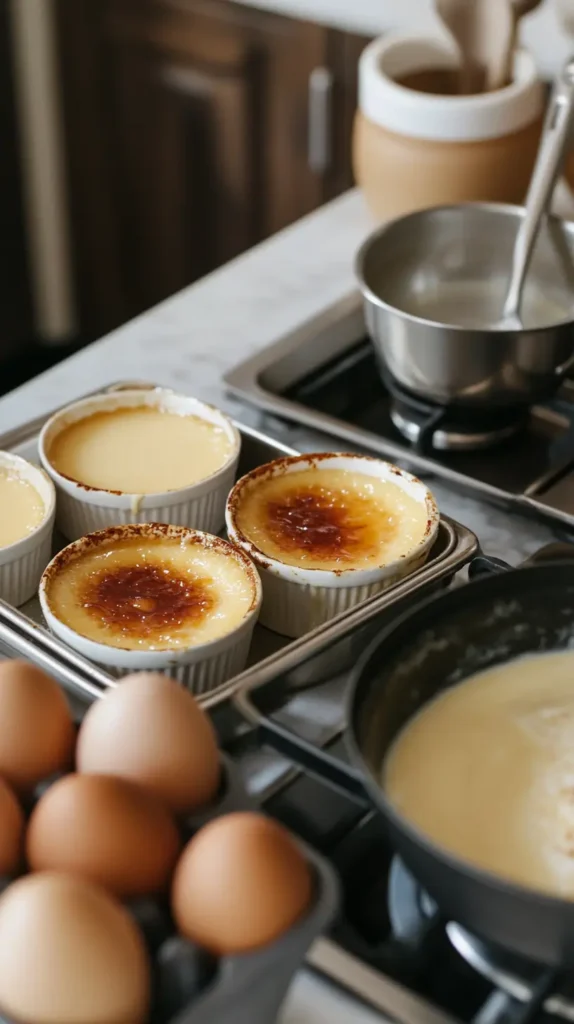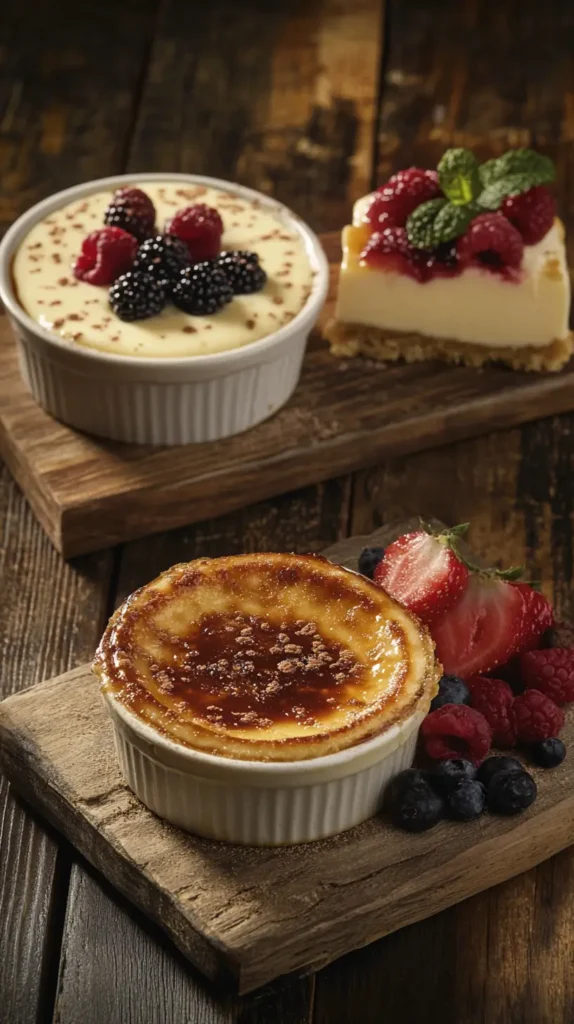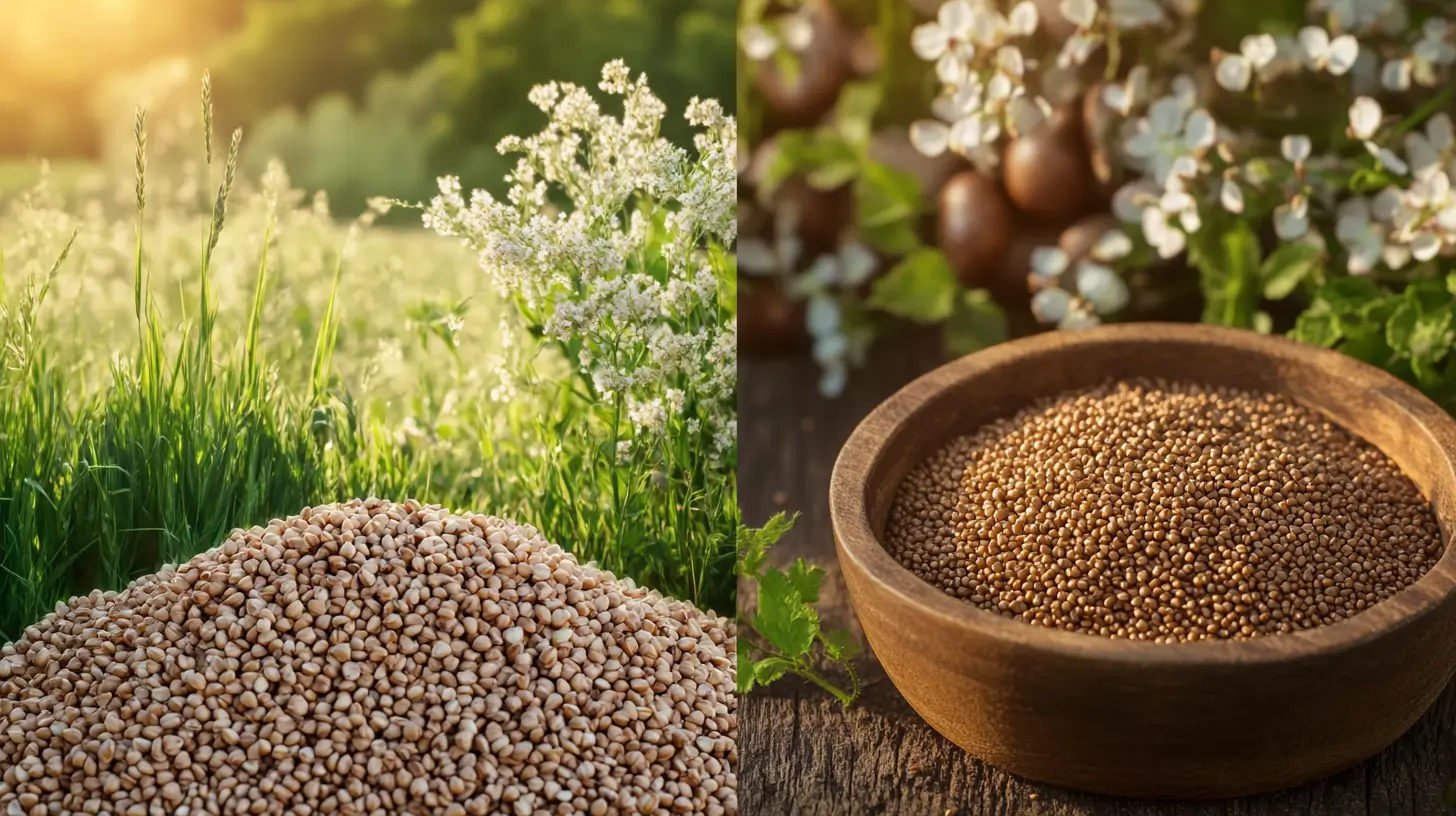Crème brûlée and custard are two iconic desserts often celebrated for their creamy texture and rich flavors. While they may appear similar at first glance, they possess distinct characteristics that set them apart. But what’s the difference between crème brûlée and custard, and how did these desserts earn their place in culinary history? Understanding their origins, ingredients, and preparation methods reveals the nuances that make each dessert unique.
What are Crème Brûlée and Custard?
The French dessert crème brûlée features a silky custard base with a layer of hardened caramelized sugar on top. This combination contrasts the smooth interior with the brittle topping. In contrast, custard encompasses a broad category of desserts made with milk or cream and egg yolks, sometimes sweetened, and prepared in various ways.
When pondering what’s the difference between crème brûlée and custard, it’s essential to note that crème brûlée is a specific type of custard with its defining caramel topping.
Historical Background of Both Desserts
Custard has a long and storied history, with its origins tracing back to Ancient Rome, where milk and eggs were combined to create savory and sweet dishes. Over time, this simple mixture evolved, becoming a staple across Europe and beyond. Crème brûlée, though rooted in custard, first appeared in French cookbooks in the late 17th century.
These desserts share a history, but understanding what’s the difference between crème brûlée and custard highlights how regional culinary traditions influenced their development.
Key Ingredients of Crème Brûlée and Custard
The Essential Ingredients of Crème Brûlée
Crème brûlée relies on a minimalist approach to ingredients. Its base typically includes heavy cream, egg yolks, sugar, and vanilla. This simplicity ensures the focus remains on the rich custard base and the satisfying caramel crunch. Achieving its signature flavor and texture requires high-quality ingredients.
Common Ingredients in Custard Recipes
Custard, being more versatile, uses a similar base of milk or cream, eggs, and sugar. However, additional ingredients such as cornstarch, gelatin, or flavorings like cinnamon and nutmeg are common. These additions allow for diverse textures and flavors, depending on the intended dish.
Ingredient Similarities and Differences
While both desserts share fundamental ingredients, the key difference lies in their proportions and specific additions. Crème brûlée’s heavy cream creates a richer taste compared to custards often made with milk. Addressing what’s the difference between crème brûlée and custard, crème brûlée’s caramel topping and absence of thickeners like cornstarch stand out.
Preparation Techniques
How Crème Brûlée Is Made
To make crème brûlée, combine cream, sugar, and egg yolks, heating them gently to prevent curdling. After preparation, pour the mixture into ramekins and bake it in a water bath to achieve its signature creamy texture. The process culminates in caramelization, where sugar is torched until golden brown to form a brittle crust.
Custard Preparation Methods
Custard preparation varies widely depending on its type. For baked custard, ingredients are mixed and baked similarly to crème brûlée. Stovetop custards, like pastry cream, are cooked over low heat while continuously stirred to prevent curdling. This versatility distinguishes custard when examining what’s the difference between crème brûlée and custard.
Comparing Cooking Techniques
The techniques for preparing these desserts reveal subtle distinctions. Crème brûlée’s water bath and caramelization step add complexity to its process, while custards can be made with more straightforward stovetop methods. These differences illuminate what’s the difference between crème brûlée and custard in terms of effort and expertise required.
Texture and Flavor Profiles
The Creamy Texture of Custard
Custard’s smooth and velvety texture comes from its balanced mixture of milk, eggs, and sometimes thickeners. This makes it adaptable for both firm and pourable variations. The creamy consistency of custard is a hallmark of its appeal.
Crème Brûlée’s Caramelized Crunch and Smooth Custard
Crème brûlée offers a unique texture contrast with its hard caramel topping and soft custard base. Breaking through the sugar crust reveals a luxurious interior, which sets it apart when considering what’s the difference between crème brûlée and custard.
How Flavor Varies Between the Two Desserts
While custard’s flavor depends heavily on added ingredients, crème brûlée focuses on a pure vanilla essence enhanced by the caramelization process. This creates a more indulgent experience, showcasing the nuanced answer to what’s the difference between crème brûlée and custard.
Cooking Methods
Baking Methods Used for Custards
Custards are baked either directly or in a water bath to ensure even cooking. The water bath prevents the eggs from curdling, resulting in a silky texture. This technique is shared with crème brûlée, demonstrating their culinary connection.
How to Achieve the Perfect Brûlée Topping
The hallmark of crème brûlée lies in its caramelized sugar crust. Achieving this requires sprinkling sugar evenly over the surface and using a culinary torch to melt it. The result is a perfectly hardened layer that contrasts beautifully with the creamy base.
Variations in Cooking Times and Temperatures
Crème brûlée often requires longer cooking times due to its thick cream base, while custards vary widely depending on their type. Exploring what’s the difference between crème brûlée and custard highlights the subtle adjustments in temperature and timing needed for each dessert.

Cultural and Culinary Significance
Custard’s Role in Different Cuisines
Custard is a versatile dish found worldwide, from British custard tarts to Italian zabaglione. Its adaptability has made it a staple in countless culinary traditions, proving its universal appeal.
Crème Brûlée as a Symbol of Elegance
Crème brûlée is often associated with fine dining due to its intricate preparation and luxurious presentation. It represents sophistication, making it a preferred choice for special occasions.
How Both Desserts Have Evolved Over Time
Both crème brûlée and custard have evolved through innovations in flavors and techniques. Today, they are celebrated in modern cuisine, yet their traditional roots remain evident. Understanding what’s the difference between crème brûlée and custard emphasizes their unique but intertwined histories.
Nutritional Comparison
Calories, Fat, and Sugar Content
Crème brûlée is typically higher in calories and fat due to its heavy cream content and caramelized sugar topping. Custards, especially those made with milk, can be lighter, making them a more calorie-conscious option.
Healthier Alternatives and Variations
For healthier versions, crème brûlée can be made with coconut cream or sugar substitutes, while custards benefit from plant-based milk and reduced sweeteners. These modifications make both desserts accessible to various dietary preferences.
Comparing Nutritional Values
When comparing what’s the difference between crème brûlée and custard, crème brûlée’s richness contrasts with custard’s versatility in being adapted to healthier variations. This highlights the nutritional trade-offs between indulgence and flexibility.
Popular Variations
Regional Custard Variations
Custard enjoys a wide range of regional variations that highlight its versatility. In the UK, custard is often served as a pourable sauce for puddings, while in Italy, zabaglione is a lighter, frothy custard. Across Asia, custard appears in dishes like Chinese steamed custard buns and Filipino leche flan.
Exploring these variations showcases how cultural influences shape custard while clarifying what’s the difference between crème brûlée and custard in terms of global interpretations.
Unique Takes on Crème Brûlée
Crème brûlée has inspired many creative versions, from matcha-flavored brûlée in Japan to espresso-infused options popular in cafés. Chefs often experiment with toppings, such as incorporating fruits, spices, or liqueurs into the caramelized sugar layer. These adaptations enhance its appeal while retaining its distinctive character.
Modern Twists on Both Recipes
Modern culinary trends have led to innovations in both custard and crème brûlée. Custard-based desserts now include vegan versions using plant-based milk and egg substitutes. Crème brûlée, meanwhile, has found its way into fusion dishes like brûlée cheesecake and brûlée cocktails. These creative approaches redefine what’s the difference between crème brûlée and custard in contemporary cuisine.
Serving Styles
How Custard Is Traditionally Served
Custard’s serving style depends on its type. Baked custards are often served in ramekins or pie crusts, while pourable custard accompanies desserts like sticky toffee pudding or trifles. Simple and comforting, traditional custard complements a wide range of sweet treats.
Elegant Presentations for Crème Brûlée
Crème brûlée shines in its refined presentation. Typically served in individual ramekins, its golden, caramelized crust adds visual appeal. Chefs often garnish it with fresh berries or edible flowers, elevating it as a centerpiece dessert.
Accompaniments and Pairings for Both
Custard pairs well with baked goods, fruits, and compotes, enhancing its flavor profile. Crème brûlée, on the other hand, shines when paired with subtle accompaniments like shortbread or fresh berries. These thoughtful pairings highlight what’s the difference between crème brûlée and custard in their serving versatility.

Crème Brûlée and Custard in Modern Cuisine
The Popularity of Custard-Based Desserts
Custard forms the backbone of many beloved desserts, such as éclairs, crème caramel, and tarts. Its adaptability to both savory and sweet applications has solidified its place in modern menus worldwide.
Innovative Uses of Crème Brûlée
Crème brûlée has transcended its traditional form in recent years. It is now featured in non-traditional settings, such as brûlée-filled doughnuts or even savory dishes like foie gras brûlée. These innovations illustrate its culinary versatility.
Tips for Home Cooks
Making Custard from Scratch
Creating custard at home requires a steady hand and attention to detail. Whisking eggs and sugar before gradually adding warm milk ensures a smooth consistency. Cooking it over gentle heat, whether on the stove or in the oven, prevents curdling and produces a creamy result.
Secrets to Mastering Crème Brûlée
Mastering crème brûlée starts with using high-quality ingredients. A water bath ensures even cooking, while properly cooling the custard base prevents cracks. Achieving the perfect caramelized topping requires an even sugar layer and a culinary torch for precision.
Common Mistakes and How to Avoid Them
Custard-making challenges include overcooking, which results in a rubbery texture, and curdling caused by high heat. For crème brûlée, uneven caramelization or overly runny custard are frequent pitfalls. Being mindful of these issues ensures consistent results.
Tools and Equipment Needed
Essential Tools for Custard Preparation
- Whisks and mixing bowls for combining ingredients.
- A fine-mesh sieve for straining the custard mixture.
- Baking dishes or ramekins for even cooking.
- A water bath setup to maintain consistent heat.
Tools for Perfecting Crème Brûlée
- Ramekins with a flat base for even caramelization.
- A culinary torch for achieving the signature brûlée topping.
- A digital thermometer to monitor the cooking temperature.
- A heatproof spatula for mixing the custard base.
Common Misconceptions
Misunderstandings About Custard
One common misconception is that all custards are desserts. While sweet custards are well-known, savory varieties like quiche custards are equally significant. Another myth is that custard must contain cornstarch, which is true only for specific recipes.
Debunking Myths About Crème Brûlée
A frequent misunderstanding is that crème brûlée is difficult to make. In reality, with the right tools and techniques, it’s approachable for home cooks. Another myth is that it always requires a torch; while preferred, broiling can achieve similar results.
FAQs
Is Crème Brûlée the Same as Custard?
No, crème brûlée is not exactly the same as custard, although it is a type of custard. Custard refers to a broad category of desserts made with a mixture of eggs, milk or cream, and sugar, cooked gently to achieve a creamy texture. Crème brûlée, on the other hand, is a specific custard dessert that includes a caramelized sugar topping, creating a crisp contrast to the smooth custard base. While all crème brûlée is custard, not all custards are crème brûlée.
What Are the 3 Types of Custard?
Custard can be categorized into three main types, based on its preparation method and consistency:
- Stirred Custard: This is cooked on the stovetop with constant stirring, resulting in a pourable consistency. Examples include crème anglaise and custard sauces.
- Baked Custard: These are cooked in the oven, often in a water bath, to achieve a firmer texture. Examples include flan, crème caramel, and custard tarts.
- Set Custard: Thickened using cornstarch or gelatin rather than relying solely on eggs, set custards are typically used for desserts like pastry cream or panna cotta.
Each type highlights the versatility of custard in various culinary applications.
Is Crème Brûlée Served Warm or Cold?
Crème brûlée is traditionally served cold, with the exception of its caramelized sugar topping, which is freshly torched before serving. This creates a delightful contrast between the chilled, creamy custard base and the warm, brittle sugar crust. Serving it this way enhances the dessert’s signature texture and flavor.
Is Crème Brûlée Basically Pudding?
No, crème brûlée is not the same as pudding, though they share similarities in texture. Pudding, particularly in the American sense, is often thickened with cornstarch or gelatin and does not rely heavily on eggs. Crème brûlée, however, is an egg-based custard made with cream and is baked in a water bath to achieve its signature richness. The caramelized sugar topping is another distinct feature that sets crème brûlée apart from pudding.
Conclusion
Recap of the Main Differences
Understanding what’s the difference between crème brûlée and custard highlights their unique textures, flavors, and preparation methods. Custard’s versatility spans savory and sweet dishes, while crème brûlée’s caramelized topping and indulgent nature make it a show-stopper.
Why Both Desserts Deserve a Place in Your Repertoire
Custard and crème brûlée offer endless possibilities for creativity and enjoyment. Whether you prefer custard’s adaptability or crème brûlée’s elegance, both desserts are timeless classics worth mastering in any kitchen.





